Development of a Land Surface Temperature Retrieval Algorithm from GK2A/AMI
Abstract
1. Introduction
2. Data and Methods
2.1. Data
2.1.1. GK2A Data
2.1.2. Validation data
2.2. Methodology
3. Results
3.1. Results of the Radiative Transfer Model Simulation
3.2. Comparison of Retrieved GK2A LST and MODIS LST Products
3.3. Validation Using In-Situ Observation Data
4. Discussion
5. Conclusions
Author Contributions
Funding
Acknowledgments
Conflicts of Interest
References
- Dash, P.; Göttsche, F.; Olesen, F.-S.; Fischer, H. Land surface temperature and emissivity estimation from passive sensor data: Theory and practice-current trends. Int. J. Remote Sens. 2002, 23, 2563–2594. [Google Scholar] [CrossRef]
- Becker, F.; Li, Z.-L. Surface temperature and emissivity at various scales: Definition, measurement and related problems. Remote Sens. Rev. 1995, 12, 225–253. [Google Scholar] [CrossRef]
- Song, Z.; Li, R.; Qiu, R.; Liu, S.; Tan, C.; Li, Q.; Ge, W.; Han, X.; Tang, X.; Shi, W.-Y.; et al. Global Land Surface Temperature Influenced by Vegetation Cover and PM2.5 from 2001 to 2016. Remote Sens. 2018, 10, 2034. [Google Scholar] [CrossRef]
- Wang, K.; Wan, Z.; Sparrow, M.; Liu, J.; Zhou, X.; Haginoya, S. Estimation of surface long wave radiation and broadband emissivity using Moderate Resolution Imaging Spectroradiometer (MODIS) land surface temperature/emissivity products. J. Geophys. Res. Space Phys. 2005, 110, D11. [Google Scholar] [CrossRef]
- Chen, Y.; Yang, K.; He, J.; Qin, J.; Shi, J.; Du, J.; He, Q. Improving land surface temperature modeling for dry land of China. J. Geophys. Res. Space Phys. 2011, 116, D20. [Google Scholar] [CrossRef]
- Dousset, B.; Gourmelon, F.; Laaidi, K.; Zeghnoun, A.; Giraudet, E.; Bretin, P.; Mauri, E.; Vandentorren, S. Satellite monitoring of summer heat waves in the Paris metropolitan area. Int. J. Clim. 2010, 31, 313–323. [Google Scholar] [CrossRef]
- Julien, Y.; Sobrino, J.A.; Verhoef, W. Changes in land surface temperatures and NDVI values over Europe between 1982 and 1999. Remote Sens. Environ. 2006, 103, 43–55. [Google Scholar] [CrossRef]
- Ibrahim, G.R.F. Urban Land Use Land Cover Changes and Their Effect on Land Surface Temperature: Case Study Using Dohuk City in the Kurdistan Region of Iraq. Climate 2017, 5, 13. [Google Scholar] [CrossRef]
- Hereher, M. Effect of land use/cover change on land surface temperatures—The Nile Delta, Egypt. J. Afr. Earth Sci. 2017, 126, 75–83. [Google Scholar] [CrossRef]
- Zhao, L.; Yang, Z.-L.; Hoar, T.J. Global Soil Moisture Estimation by Assimilating AMSR-E Brightness Temperatures in a Coupled CLM4–RTM–DART System. J. Hydrometeorol. 2016, 17, 2431–2454. [Google Scholar] [CrossRef]
- Marcos, E.; Fernández-García, V.; Fernández-Manso, A.; Quintano, C.; Valbuena, L.; Tárrega, R.; Luis-Calabuig, E.; Calvo, L. Evaluation of Composite Burn Index and Land Surface Temperature for Assessing Soil Burn Severity in Mediterranean Fire-Prone Pine Ecosystems. Forest 2018, 9, 494. [Google Scholar] [CrossRef]
- Maffei, C.; Alfieri, S.; Menenti, M. Relating Spatiotemporal Patterns of Forest Fires Burned Area and Duration to Diurnal Land Surface Temperature Anomalies. Remote Sens. 2018, 10, 1777. [Google Scholar] [CrossRef]
- Elvira, B.G.; Taylor, C.M.; Harris, P.P.; Ghent, D.; Veal, K.L.; Folwell, S.S. Global observational diagnosis of soil moisture control on the land surface energy balance. Geophys. Res. Lett. 2016, 43, 2623–2631. [Google Scholar] [CrossRef]
- Hain, C.; Anderson, M.C. Estimating morning change in land surface temperature from MODIS day/night observations: Applications for surface energy balance modeling. Geophys. Res. Lett. 2017, 44, 9723–9733. [Google Scholar] [CrossRef]
- Jung, H.-S.; Lee, K.-T.; Zo, I.-S. Calculation Algorithm of Upward Longwave Radiation Based on Surface Types. Asia Pac. J. Atmos. Sci. 2020, 56, 291–306. [Google Scholar] [CrossRef]
- Peng, J.; Ma, J.; Liu, Q.; Yanxu, L.; Hu, Y.; Li, Y.; Yue, Y. Spatial-temporal change of land surface temperature across 285 cities in China: An urban-rural contrast perspective. Sci. Total Environ. 2018, 635, 487–497. [Google Scholar] [CrossRef] [PubMed]
- Anastasios, P.; Theleia, M.; Constantinos, C. Quantifying the trends in land surface temperature and surface urban heat island intensity in mediterranean cities in view of smart urbanization. Urban Sci. 2018, 2, 16. [Google Scholar] [CrossRef]
- Zhou, D.; Xiao, J.; Bonafoni, S.; Thau, C.; Deilami, K.; Zhou, Y.; Frolking, S.; Yao, R.; Qiao, Z.; Sobrino, J.A. Satellite Remote Sensing of Surface Urban Heat Islands: Progress, Challenges, and Perspectives. Remote Sens. 2018, 11, 48. [Google Scholar] [CrossRef]
- Song, L.; Liu, S.; Kustas, W.P.; Nieto, H.; Sun, L.; Xu, Z.; Skaggs, T.H.; Yang, Y.; Ma, M.; Xu, T.; et al. Monitoring and validating spatially and temporally continuous daily evaporation and transpiration at river basin scale. Remote Sens. Environ. 2018, 219, 72–88. [Google Scholar] [CrossRef]
- Tomlinson, C.J.; Chapman, L.; Thornes, J.E.; Baker, C. Remote sensing land surface temperature for meteorology and climatology: A review. Meteorol. Appl. 2011, 18, 296–306. [Google Scholar] [CrossRef]
- Zhan, W.; Chen, Y.; Zhou, J.; Wang, J.; Liu, W.; Voogt, J.; Zhu, X.; Quan, J.; Li, J. Disaggregation of remotely sensed land surface temperature: Literature survey, taxonomy, issues, and caveats. Remote Sens. Environ. 2013, 131, 119–139. [Google Scholar] [CrossRef]
- Weng, Q.; Fu, P.; Gao, F. Generating daily land surface temperature at Landsat resolution by fusing Landsat and MODIS data. Remote Sens. Environ. 2014, 145, 55–67. [Google Scholar] [CrossRef]
- Li, Z.-L.; Tang, B.-H.; Wu, H.; Ren, H.; Yan, G.; Wan, Z.; Trigo, I.F.; Sobrino, J.A. Satellite-derived land surface temperature: Current status and perspectives. Remote Sens. Environ. 2013, 131, 14–37. [Google Scholar] [CrossRef]
- Sattari, F.; Hashim, M. A brief review of land surface temperature retrieval methods from thermal satellite sensors. Middle East J. Sci. Res. 2014, 22, 757–768. [Google Scholar]
- Becker, F.; Li, Z.-L. Temperature-independent spectral indices in thermal infrared bands. Remote Sens. Environ. 1990, 32, 17–33. [Google Scholar] [CrossRef]
- Sobrino, J.A.; Li, Z.-L.; Stoll, M.; Becker, F. Improvements in the split-window technique for land surface temperature determination. IEEE Trans. Geosci. Remote Sens. 1994, 32, 243–253. [Google Scholar] [CrossRef]
- Wan, Z.; Dozier, J. A Generalized Split-Window Algorithm for Retrieving Land-Surface Temperature Measurement from Space. IEEE Trans. Geosci Remote Sens. 1996, 34, 892–905. [Google Scholar]
- Gillespie, A.; Rokugawa, S.; Matsunaga, T.; Cothern, J.; Hook, S.; Kahle, A. A temperature and emissivity separation algorithm for Advanced Spaceborne Thermal Emission and Reflection Radiometer (ASTER) images. IEEE Trans. Geosci. Remote Sens. 1998, 36, 1113–1126. [Google Scholar] [CrossRef]
- Yu, Y.; Privette, J.L.; Pinheiro, A. Analysis of the NPOESS VIIRS land surface temperature algorithm using MODIS data. IEEE Trans. Geosci. Remote Sens. 2005, 43, 2340–2350. [Google Scholar] [CrossRef]
- Justice, C.O.; Román, M.O.; Csiszar, I.; Vermote, E.F.; Wolfe, R.E.; Hook, S.J.; Friedl, M.; Wang, Z.; Schaaf, C.; Miura, T.; et al. Land and cryosphere products from Suomi NPP VIIRS: Overview and status. J. Geophys. Res. Atmos. 2013, 118, 9753–9765. [Google Scholar] [CrossRef]
- Yu, X.; Guo, X.; Wu, Z. Land Surface Temperature Retrieval from Landsat 8 TIRS—Comparison between Radiative Transfer Equation-Based Method, Split Window Algorithm and Single Channel Method. Remote Sens. 2014, 6, 9829–9852. [Google Scholar] [CrossRef]
- Wan, Z. New refinements and validation of the collection-6 MODIS land-surface temperature/emissivity product. Remote Sens. Environ. 2014, 140, 36–45. [Google Scholar] [CrossRef]
- Sun, D. Estimation of land surface temperature from a Geostationary Operational Environmental Satellite (GOES-8). J. Geophys. Res. Space Phys. 2003, 108, 4326. [Google Scholar] [CrossRef]
- Sobrino, J.A.; Romaguera, M. Land surface temperature retrieval from MSG1-SEVIRI data. Remote Sens. Environ. 2004, 92, 247–254. [Google Scholar] [CrossRef]
- Hong, K.-O.; Suh, M.-S.; Kang, J.-H. Development of a land surface temperature-retrieval algorithm from MTSAT-1R data. Asia Pac. J. Atmos. Sci. 2009, 45, 411–421. [Google Scholar]
- Cho, A.-R.; Suh, M.-S. Evaluation of Land Surface Temperature Operationally Retrieved from Korean Geostationary Satellite (COMS) Data. Remote Sens. 2013, 5, 3951–3970. [Google Scholar] [CrossRef]
- Göttsche, F.; Olesen, F.-S.; Trigo, I.F.; Bork-Unkelbach, A.; Martin, M. Long Term Validation of Land Surface Temperature Retrieved from MSG/SEVIRI with Continuous in-Situ Measurements in Africa. Remote Sens. 2016, 8, 410. [Google Scholar] [CrossRef]
- Li, Z.-L.; Becker, F. Feasibility of land surface temperature and emissivity determination from AVHRR data. Remote Sens. Environ. 1993, 43, 67–85. [Google Scholar] [CrossRef]
- Ottlé, C.; Stoll, M. Effect of atmospheric absorption and surface emissivity on the determination of land surface temperature from infrared satellite data. Int. J. Remote Sens. 1993, 14, 2025–2037. [Google Scholar] [CrossRef]
- Prata, A.J.; Caselles, V.; Coll, C.; Sobrino, J.A.; Ottlé, C. Thermal remote sensing of land surface temperature from satellites: Current status and future prospects. Remote Sens. Rev. 1995, 12, 175–224. [Google Scholar] [CrossRef]
- Jiménez-Muñoz, J.C.; Sobrino, J.A. A generalized single-channel method for retrieving land surface temperature from remote sensing data. J. Geophys. Res. Space Phys. 2003, 108, D22. [Google Scholar] [CrossRef]
- Prata, A.J. Land surface temperatures derived from the advanced very high resolution radiometer and the along-track scanning radiometer: 1. Theory. J. Geophys. Res. Space Phys. 1993, 98, 16689–16702. [Google Scholar] [CrossRef]
- Sobrino, J.A.; Li, Z.-L.; Stoll, M.P.; Becker, F. Multi-channel and multi-angle algorithms for estimating sea and land surface temperature with ATSR data. Int. J. Remote Sens. 1996, 17, 2089–2114. [Google Scholar] [CrossRef]
- Snyder, W.C.; Wan, Z.; Zhang, Y.; Feng, Y.-Z. Classification-based emissivity for land surface temperature measurement from space. Int. J. Remote Sens. 1998, 19, 2753–2774. [Google Scholar] [CrossRef]
- Peres, L.F.; Dacamara, C.C. Emissivity maps to retrieve land-surface temperature from MSG/SEVIRI. IEEE Trans. Geosci. Remote Sens. 2005, 43, 1834–1844. [Google Scholar] [CrossRef]
- Valor, E. Mapping land surface emissivity from NDVI: Application to European, African, and South American areas. Remote Sens. Environ. 1996, 57, 167–184. [Google Scholar] [CrossRef]
- Sobrino, J.A.; Raissouni, N. Toward remote sensing methods for land cover dynamic monitoring: Application to Morocco. Int. J. Remote Sens. 2000, 21, 353–366. [Google Scholar] [CrossRef]
- Jiang, G.-M.; Li, Z.-L.; Nerry, F. Land surface emissivity retrieval from combined mid-infrared and thermal infrared data of MSG-SEVIRI. Remote Sens. Environ. 2006, 105, 326–340. [Google Scholar] [CrossRef]
- Watson, K. Two-temperature method for measuring emissivity. Remote Sens. Environ. 1992, 42, 117–121. [Google Scholar] [CrossRef]
- Peres, L.F.; Dacamara, C.C.; Trigo, I.F.; Freitas, S.C. Synergistic use of the two-temperature and split-window methods for land-surface temperature retrieval. Int. J. Remote Sens. 2010, 31, 4387–4409. [Google Scholar] [CrossRef]
- Gillespie, A.R.; Abbott, E.A.; Gilson, L.; Hulley, G.; Jiménez-Muñoz, J.C.; Sobrino, J.A. Residual errors in ASTER temperature and emissivity standard products AST08 and AST05. Remote Sens. Environ. 2011, 115, 3681–3694. [Google Scholar] [CrossRef]
- Zhou, S.; Cheng, J. An Improved Temperature and Emissivity Separation Algorithm for the Advanced Himawari Imager. IEEE Trans. Geosci. Remote Sens. 2020, 1–20. [Google Scholar] [CrossRef]
- Xu, H.; Yu, Y.; Tarpley, D.; Göttsche, F.; Olesen, F.-S. Evaluation of GOES-R Land Surface Temperature Algorithm Using SEVIRI Satellite Retrievals With In Situ Measurements. IEEE Trans. Geosci. Remote Sens. 2013, 52, 3812–3822. [Google Scholar] [CrossRef]
- Yu, Y.; Liu, Y.; Yu, P.; Wang, H. Enterprise Algorithm Theoretical Basis Document for Viirs Land Surface Temperature Production; Version 1.2; NOAA: College Park, MD, USA, 2019. Available online: https://www.star.nesdis.noaa.gov/jpss/documents/ATBD/ATBD_EPS_Land_LST_v1.2.pdf (accessed on 29 June 2020).
- Yamamoto, Y.; Ishikawa, H.; Oku, Y.; Hu, Z. An Algorithm for Land Surface Temperature Retrieval Using Three Thermal Infrared Bands of Himawari-8. J. Meteorol. Soc. Jpn. 2018, 96, 59–76. [Google Scholar] [CrossRef]
- Bessho, K.; Date, K.; Hayashi, M.; Ikeda, A.; Imai, T.; Inoue, H.; Kumagai, Y.; Miyakawa, T.; Murata, H.; Ohno, T.; et al. An Introduction to Himawari-8/9—Japan’s new-generation geostationary meteorological satellites. J. Meteorol. Soc. Jpn. 2016, 94, 151–183. [Google Scholar] [CrossRef]
- Schmit, T.J.; Griffith, P.; Gunshor, M.M.; Daniels, J.; Goodman, S.J.; Lebair, W.J. A Closer Look at the ABI on the GOES-R Series. Bull. Am. Meteorol. Soc. 2017, 98, 681–698. [Google Scholar] [CrossRef]
- Chung, S.-R.; Ahn, M.-H.; Han, K.-S.; Lee, K.-T.; Shin, D.-B. Meteorological Products of Geo-KOMPSAT 2A (GK2A) Satellite. Asia Pac. J. Atmos. Sci. 2020, 56, 185. [Google Scholar] [CrossRef]
- Stuhlmann, R.; Rodriguez, A.; Tjemkes, S.; Grandell, J.; Arriaga, A.; Bezy, J.-L.; Aminou, D.; Bensi, P. Plans for EUMETSAT’s Third Generation Meteosat geostationary satellite programme. Adv. Space Res. 2005, 36, 975–981. [Google Scholar] [CrossRef]
- Choi, Y.-Y.; Suh, M.-S. Development of Himawari-8/Advanced Himawari Imager (AHI) land surface temperature retrieval algorithm. Remote Sens. 2018, 10, 2013. [Google Scholar] [CrossRef]
- NMSC. Available online: http://nmsc.kma.go.kr/enhome/html/bbs/selectNews.do?bbsCd=00237&bbsUsq=200676 (accessed on 29 June 2020).
- Lee, B.-I.; Chung, S.-R.; Baek, S. Development of cloud detection algorithm for GK-2A/AMI. In Proceedings of the 7th Asia-Oceania/2nd AMS-Asia/2nd KMA Meteorological Satellite User’s Conference, Songdo City, Korea, 24–27 October 2016; Available online: https://nmsc.kma.go.kr/enhome/html/conference/selectCfrItem.do?cfrUsq=142&cpnUsq=121&cpnDivCd=03 (accessed on 29 June 2020).
- Seong, N.-H.; Jung, D.; Kim, J.; Han, K.-S. Evaluation of NDVI Estimation Considering Atmospheric and BRDF Correction through Himawari-8/AHI. Asia Pac. J. Atmos. Sci. 2020, 56, 265–274. [Google Scholar] [CrossRef]
- Ijima, O. Basic and Other Measurements of Radiation at Station Tateno (2019-07); Aerological Observatory, Japan Meteorological Agency, PANGAEA: Tokyo, Japan, 2019; Available online: https://doi.pangaea.de/10.1594/PANGAEA.906163 (accessed on 29 June 2020).
- Ijima, O. Basic and Other Measurements of Radiation at Station Tateno (2019-08); Aerological Observatory, Japan Meteorological Agency, PANGAEA: Tokyo, Japan, 2019; Available online: https://doi.pangaea.de/10.1594/PANGAEA.908094 (accessed on 29 June 2020).
- Ijima, O. Basic and Other Measurements of Radiation at Station Tateno (2019-09); Aerological Observatory, Japan Meteorological Agency, PANGAEA: Tokyo, Japan, 2019; Available online: https://doi.pangaea.de/10.1594/PANGAEA.909250 (accessed on 29 June 2020).
- Ijima, O. Basic and Other Measurements of Radiation at Station Tateno (2019-10); Aerological Observatory, Japan Meteorological Agency, PANGAEA: Tokyo, Japan, 2019; Available online: https://doi.pangaea.de/10.1594/PANGAEA.910611 (accessed on 29 June 2020).
- Caselles, E.; Valor, E.; Abad, F.; Caselles, V. Automatic classification-based generation of thermal infrared land surface emissivity maps using AATSR data over Europe. Remote Sens. Environ. 2012, 124, 321–333. [Google Scholar] [CrossRef]
- Carlson, T.N.; Ripley, D.A. On the relation between NDVI, fractional vegetation cover, and leaf area index. Remote Sens. Environ. 1997, 62, 241–252. [Google Scholar] [CrossRef]
- Lin, J.; Feng, X.; Xiao, P.; Li, H.; Wang, J.; Li, Y. Comparison of Snow Indexes in Estimating Snow Cover Fraction in a Mountainous Area in Northwestern China. IEEE Geosci. Remote Sens. Lett. 2012, 9, 725–729. [Google Scholar] [CrossRef]
- Park, K.-A.; Woo, H.-J.; Chung, S.-R.; Cheong, S.-H. Development of Sea Surface Temperature Retrieval Algorithms for Geostationary Satellite Data (Himawari-8/AHI). Asia Pac. J. Atmos. Sci. 2020, 56, 1–20. [Google Scholar] [CrossRef]
- Korea Meteorological Administration Web Site. Available online: https://data.kma.go.kr/cmmn/main.do (accessed on 10 September 2020).
- Korea Hydrographic and Oceanographic Agency Web Site. Available online: http://www.khoa.go.kr/oceangrid/khoa/koofs.do (accessed on 10 September 2020).
- Borbas, E.; Seemann, S.W.; Huang, H.-L.; Li, J.; Menzel, W.P. Global profile training database for satellite regression retrievals with estimates of skin temperature and emissivity. In Proceedings of the 14th International ATOVS Study Conference, Beijing, China, 25–31 May 2005; pp. 763–770. [Google Scholar]
- Wan, Z. MODIS Land-Surface Temperature Algorithm Theoretical Basis Document (LST ATBD). Available online: https://modis.gsfc.nasa.gov/data/atbd/atbd_mod11.pdf (accessed on 29 June 2020).
- Yu, Y.; Tarpley, D.; Privette, J.L.; Goldberg, M.; Raja, M.R.V.; Vinnikov, K.; Xu, H. Developing Algorithm for Operational GOES-R Land Surface Temperature Product. IEEE Trans. Geosci. Remote Sens. 2008, 47, 936–951. [Google Scholar] [CrossRef]
- Coll, C.; Caselles, V. A split-window algorithm for land surface temperature from advanced very high resolution radiometer data: Validation and algorithm comparison. J. Geophys. Res. Space Phys. 1997, 102, 16697–16713. [Google Scholar] [CrossRef]
- Ren, H.; Yan, G.; Chen, L.; Li, Z. Angular effect of MODIS emissivity products and its application to the split-window algorithm. ISPRS J. Photogramm. Remote Sens. 2011, 66, 498–507. [Google Scholar] [CrossRef]
- García-Santos, V.; Coll, C.; Valor, E.; Niclòs, R.; Caselles, V. Analyzing the anisotropy of thermal infrared emissivity over arid regions using a new MODIS land surface temperature and emissivity product (MOD21). Remote Sens. Environ. 2015, 169, 212–221. [Google Scholar] [CrossRef]
- Lu, L.; Zhang, T.; Wang, T.; Zhou, X. Evaluation of Collection-6 MODIS Land Surface Temperature Product Using Multi-Year Ground Measurements in an Arid Area of Northwest China. Remote Sens. 2018, 10, 1852. [Google Scholar] [CrossRef]
- Duan, S.-B.; Li, Z.-L.; Li, H.; Göttsche, F.; Wu, H.; Zhao, W.; Leng, P.; Zhang, X.; Coll, C. Validation of Collection 6 MODIS land surface temperature product using in situ measurements. Remote Sens. Environ. 2019, 225, 16–29. [Google Scholar] [CrossRef]
- François, C.; Ottlé, C. Atmospheric corrections in the thermal infrared: Global and water vapor dependent split-window algorithms-applications to ATSR and AVHRR data. IEEE Trans. Geosci. Remote Sens. 1996, 34, 457–470. [Google Scholar] [CrossRef]
- Atitar, M.; Sobrino, J.A. A split-window algorithm for estimating LST from Meteosat 9 data: Test and comparison with data and MODIS LSTs. IEEE Geosci. Remote Sens. Lett. 2008, 6, 122–126. [Google Scholar] [CrossRef]
- Martin, M.; Ghent, D.; Pires, A.; Göttsche, F.; Cermak, J.; Remedios, J.J. Comprehensive in situ validation of five satellite land surface temperature data sets over multiple stations and years. Remote Sens. 2019, 11, 479. [Google Scholar] [CrossRef]
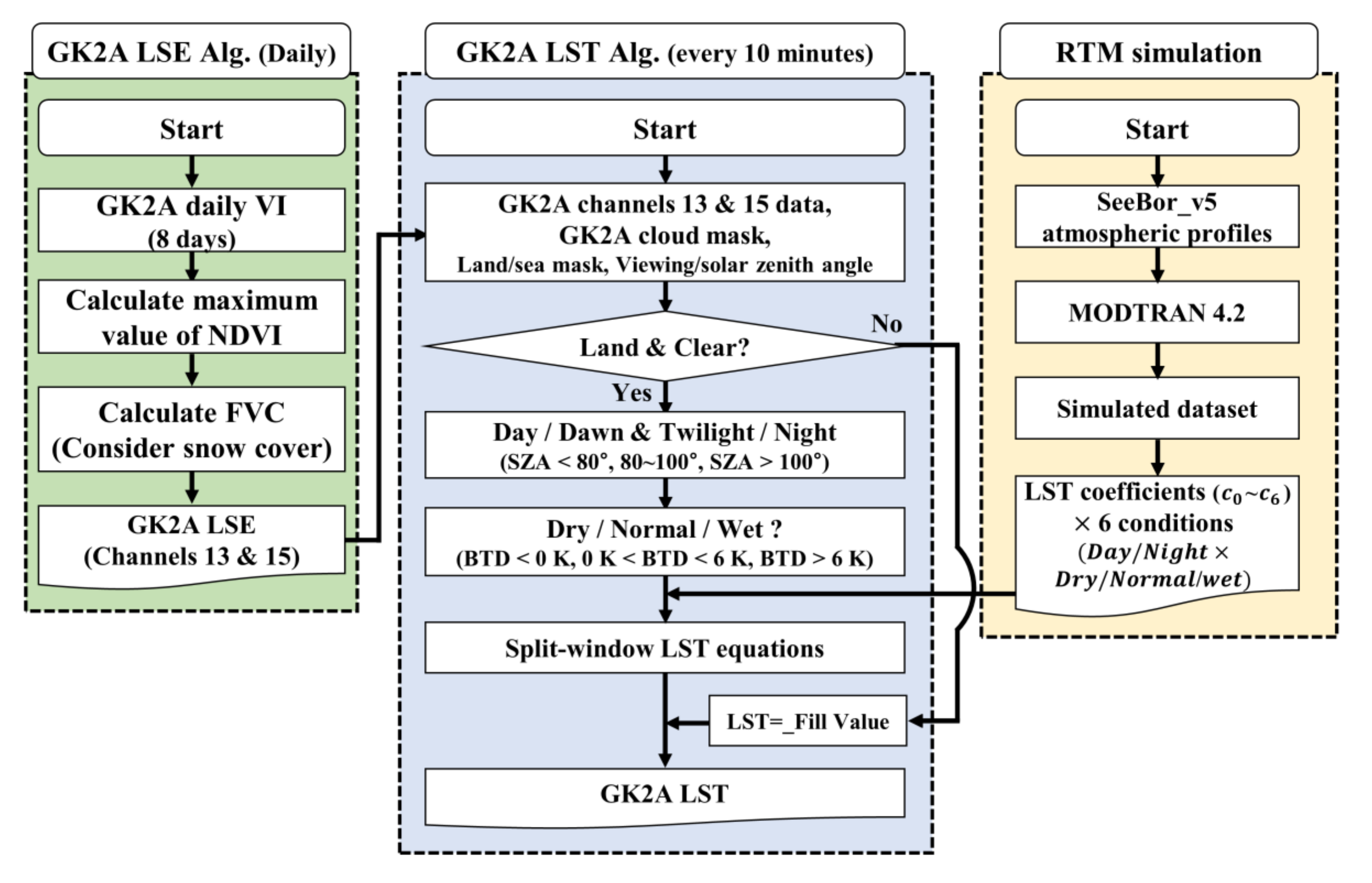
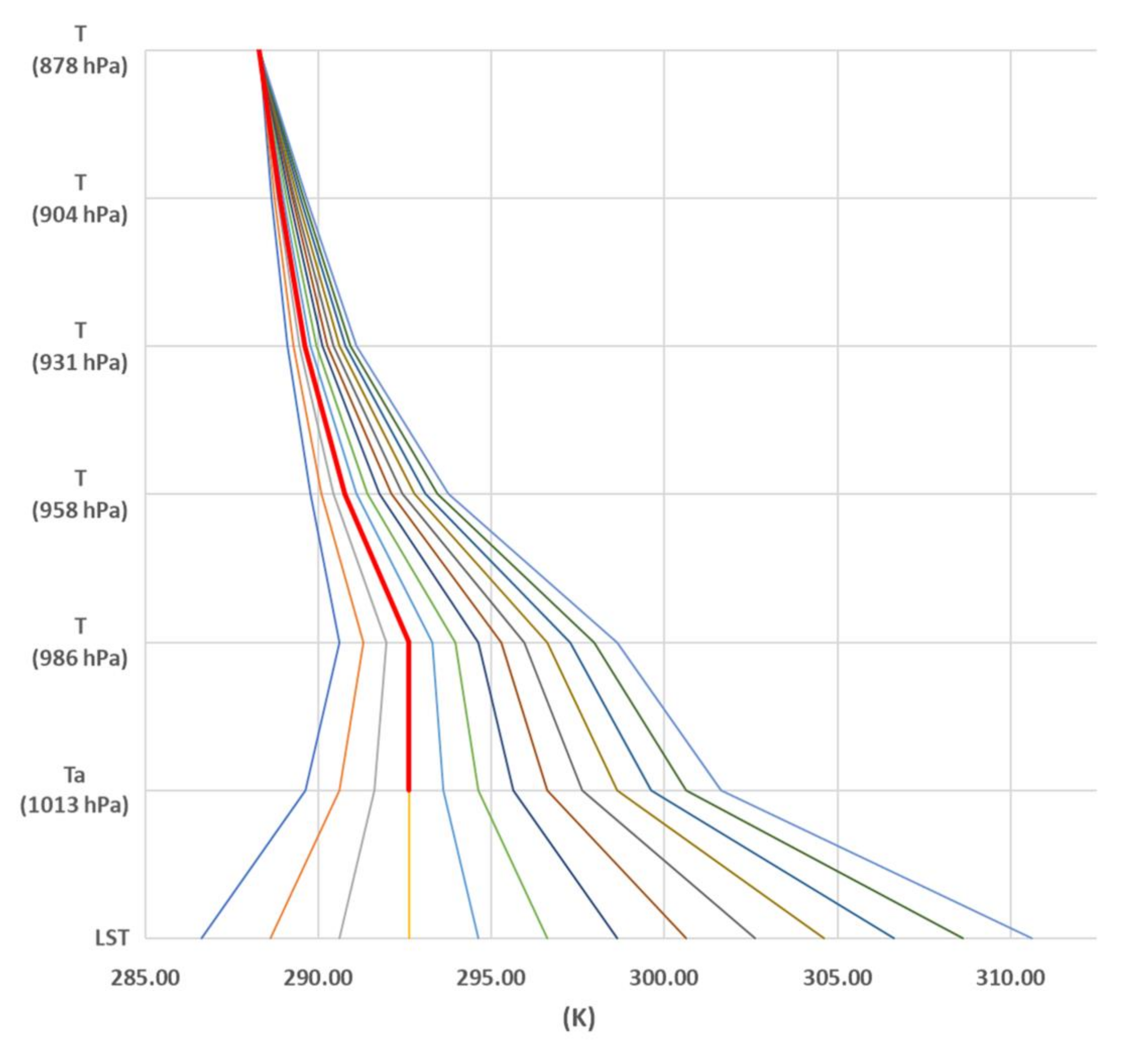

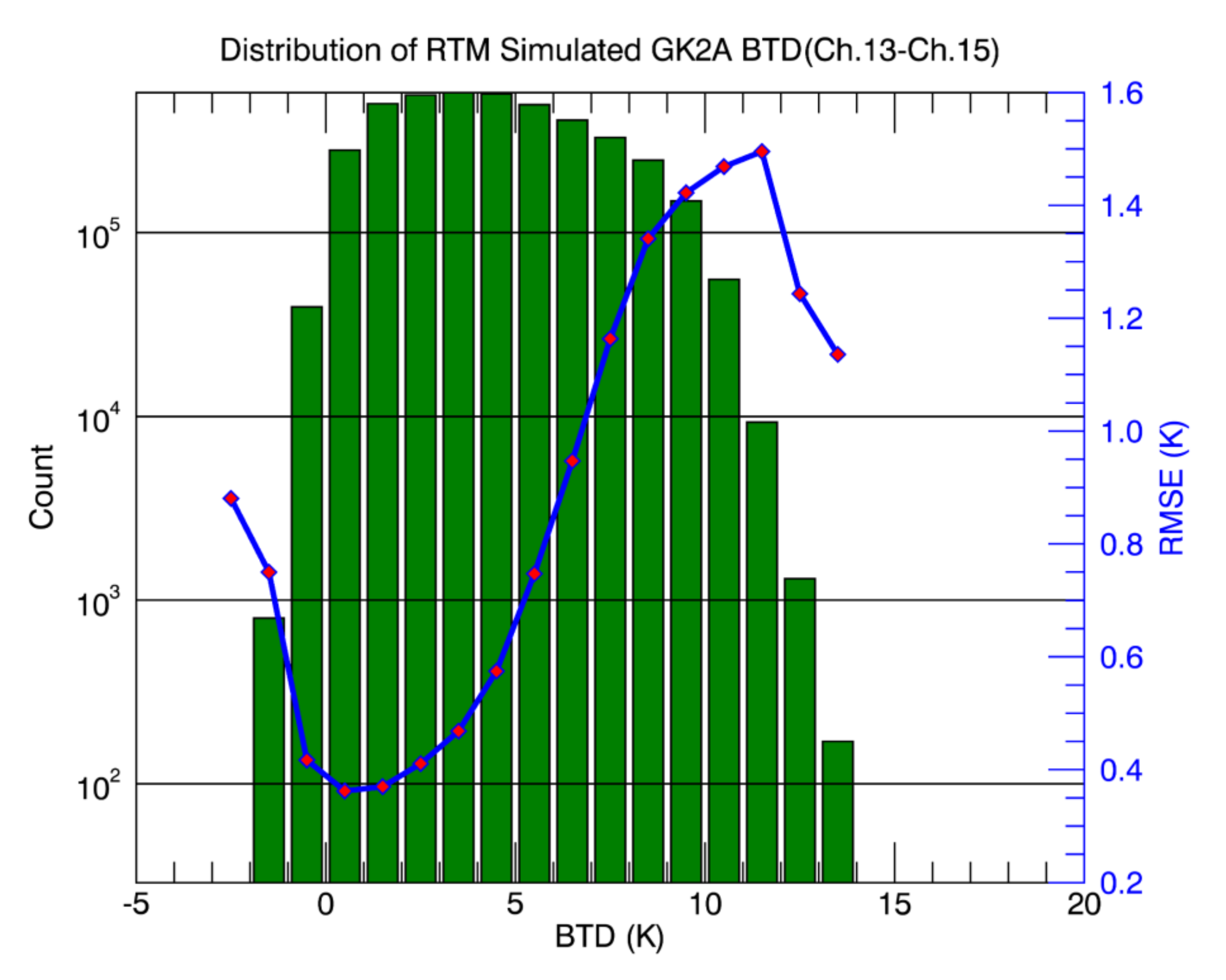
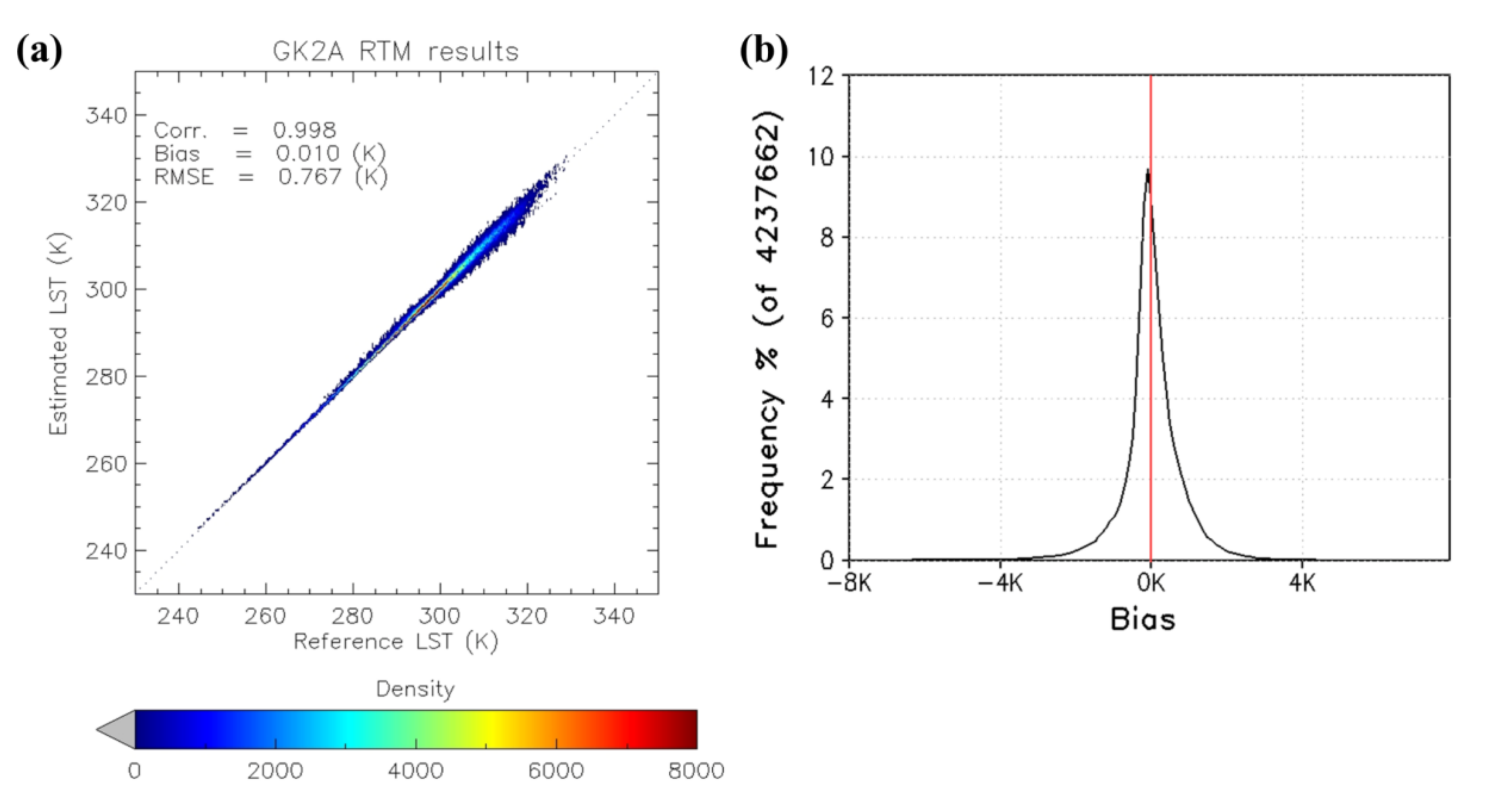
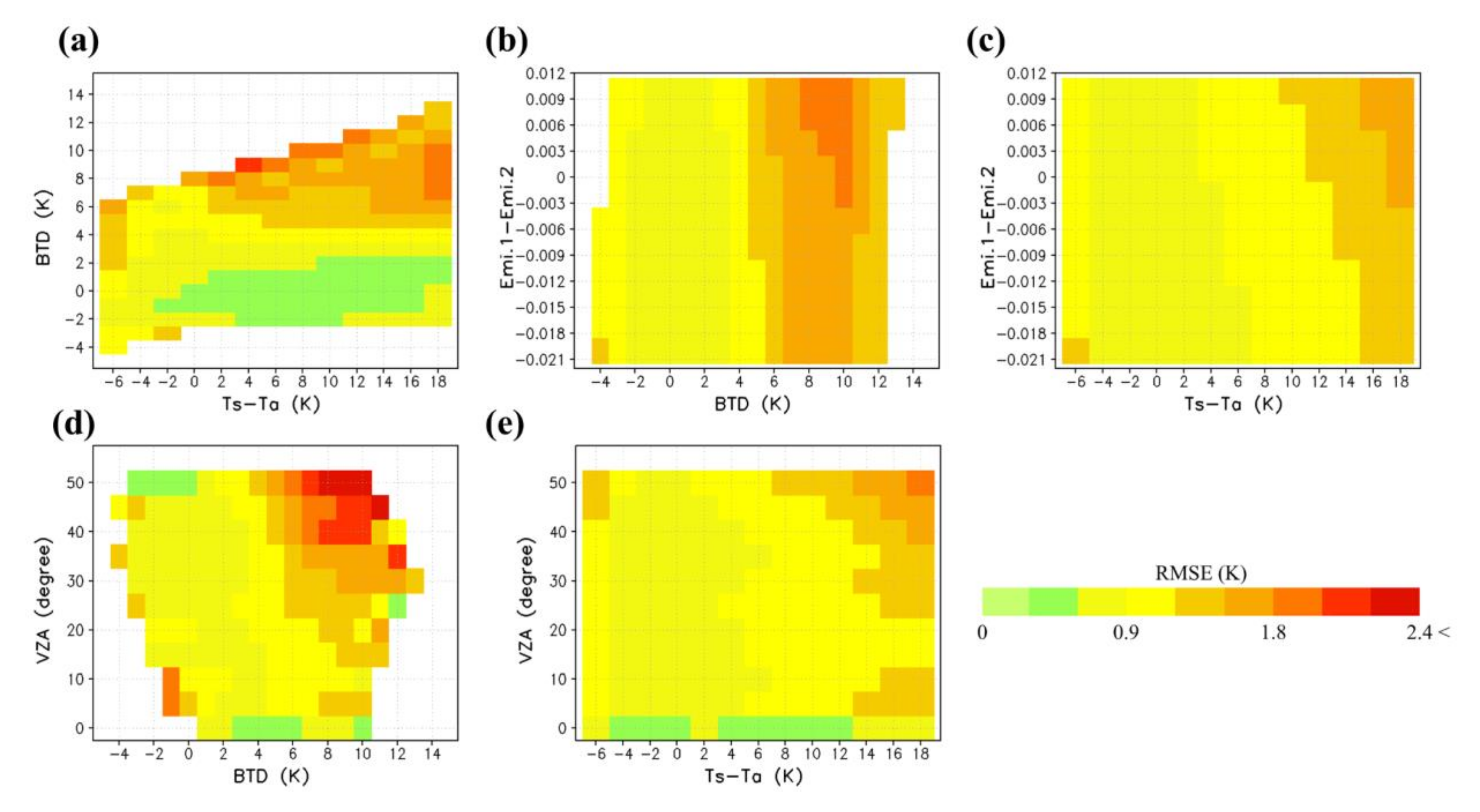
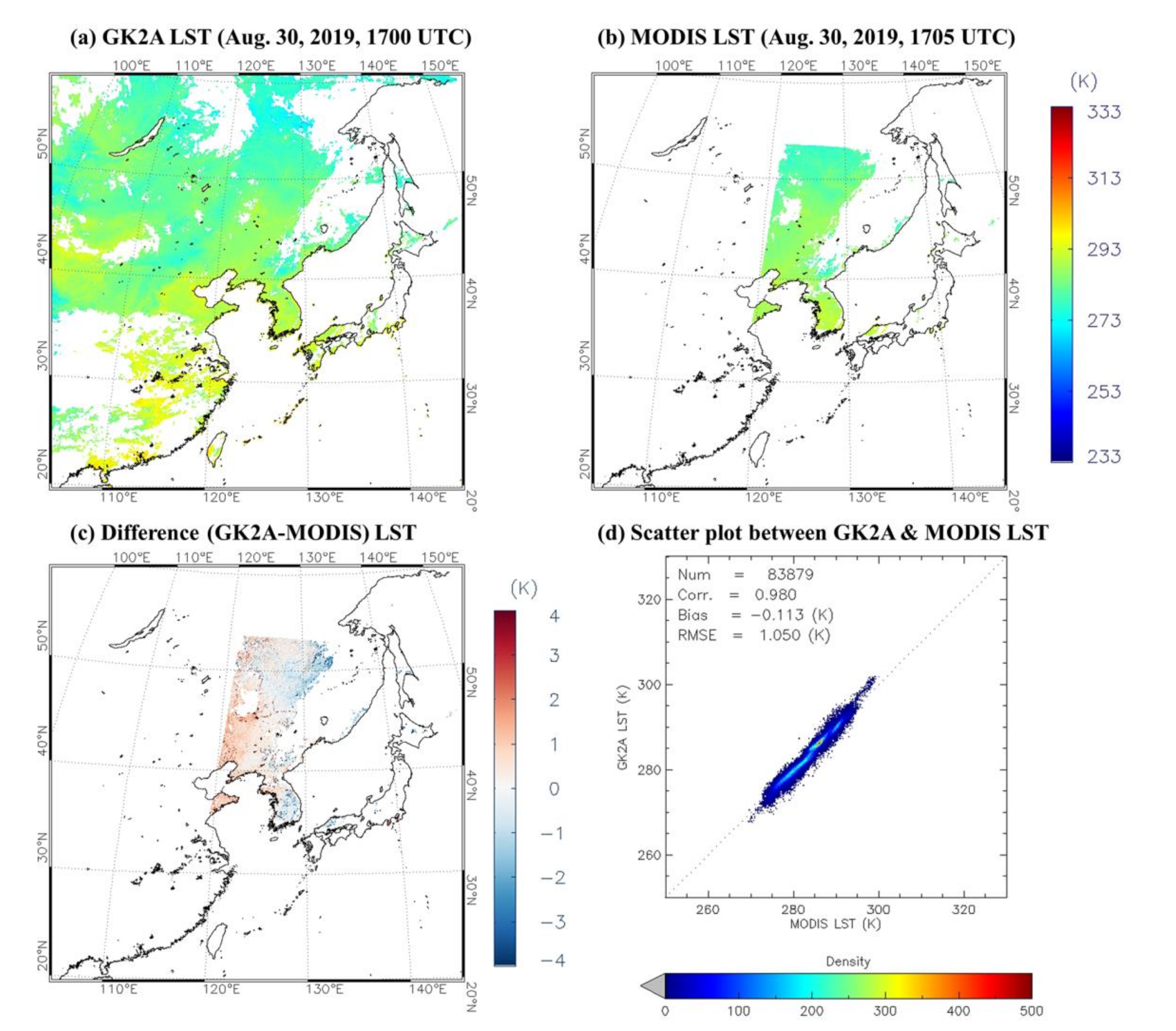

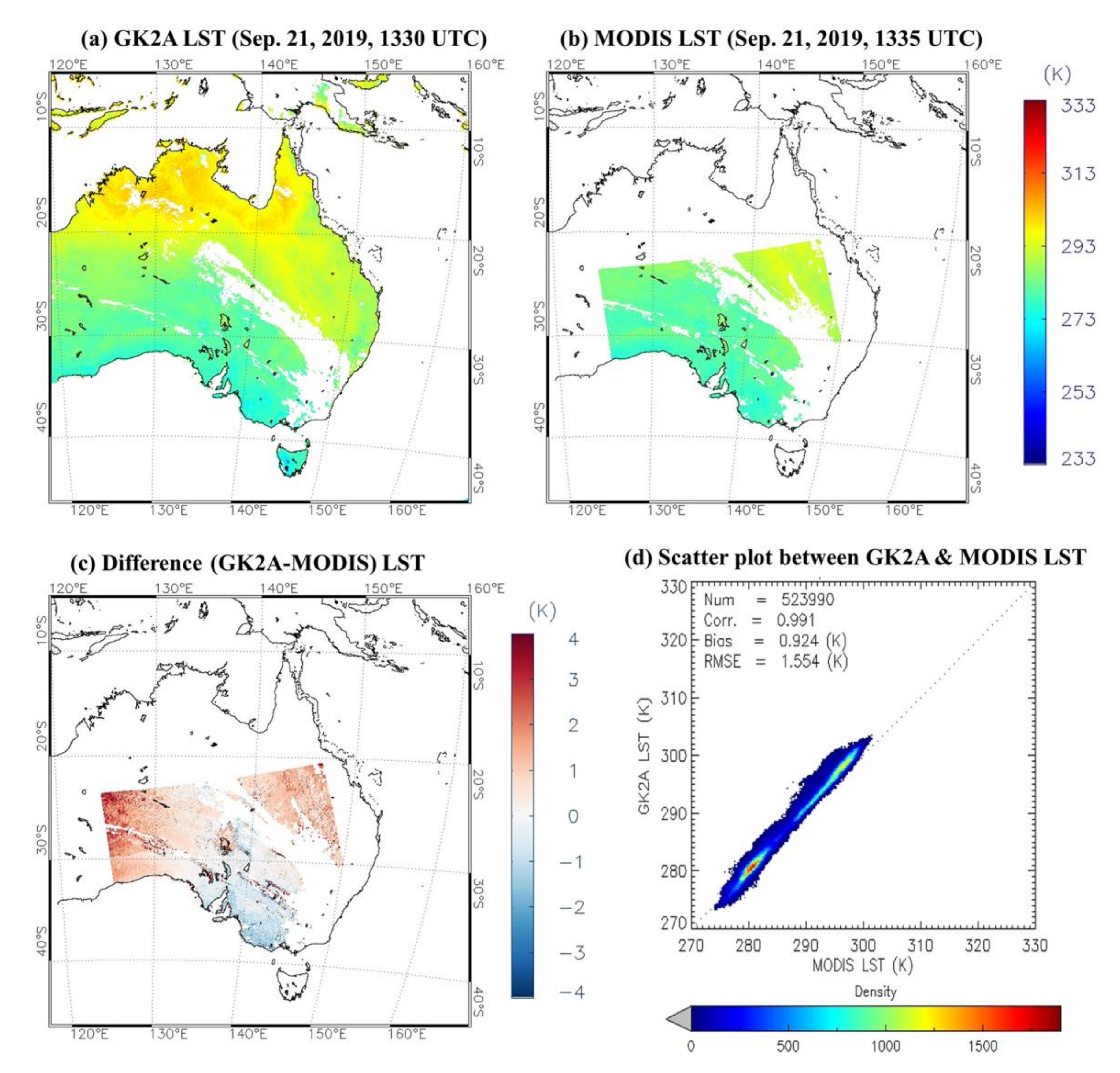
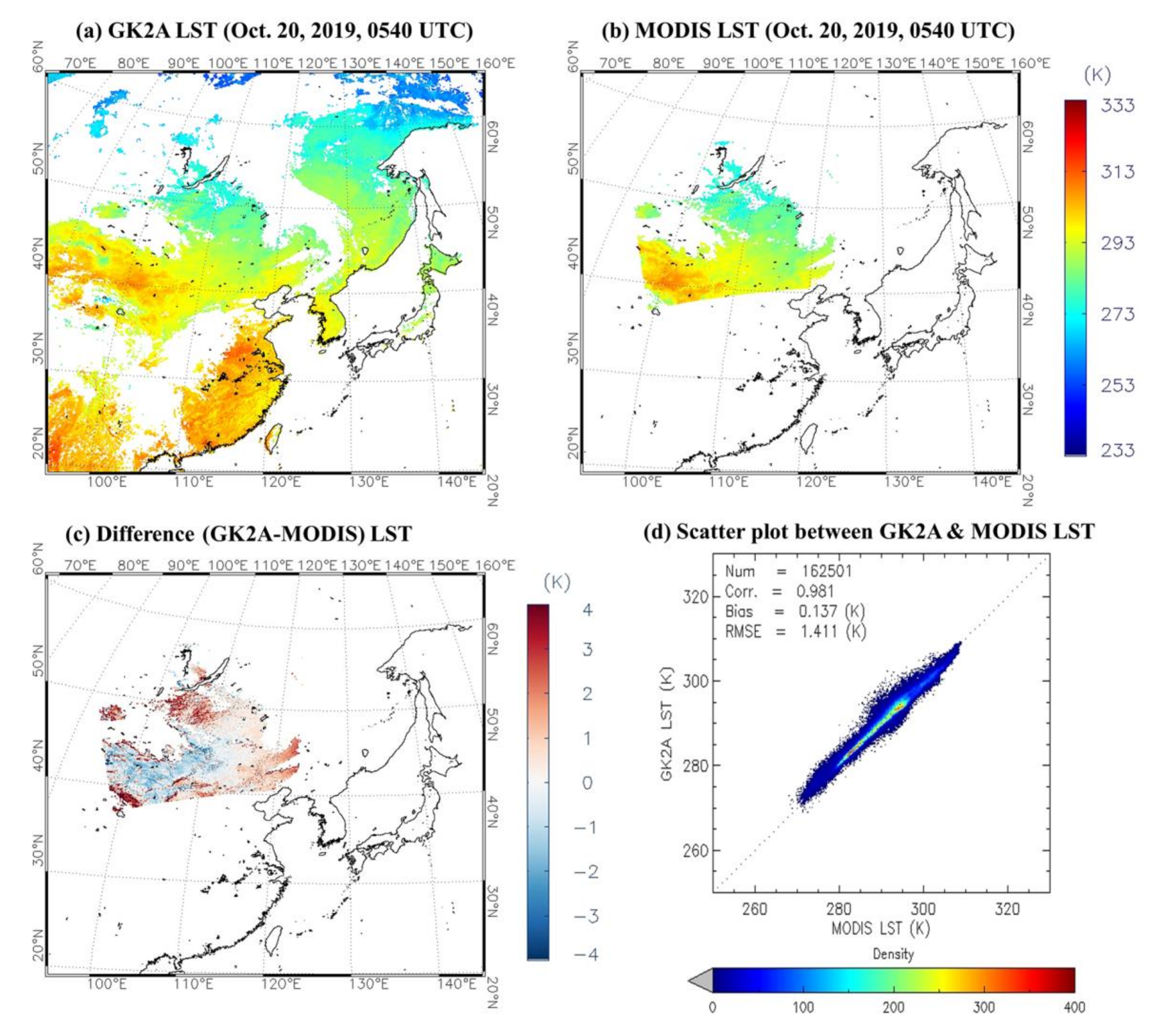
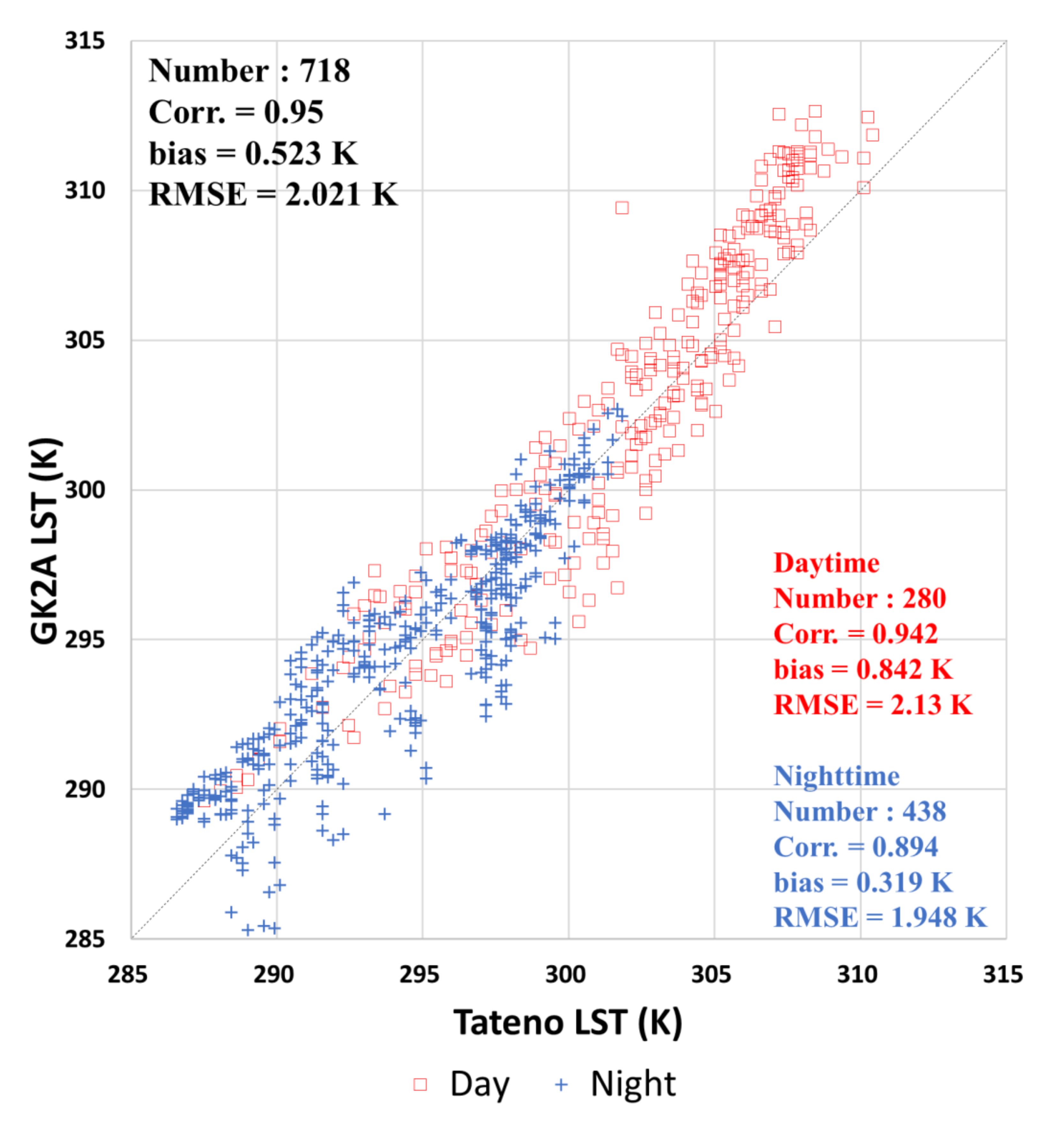
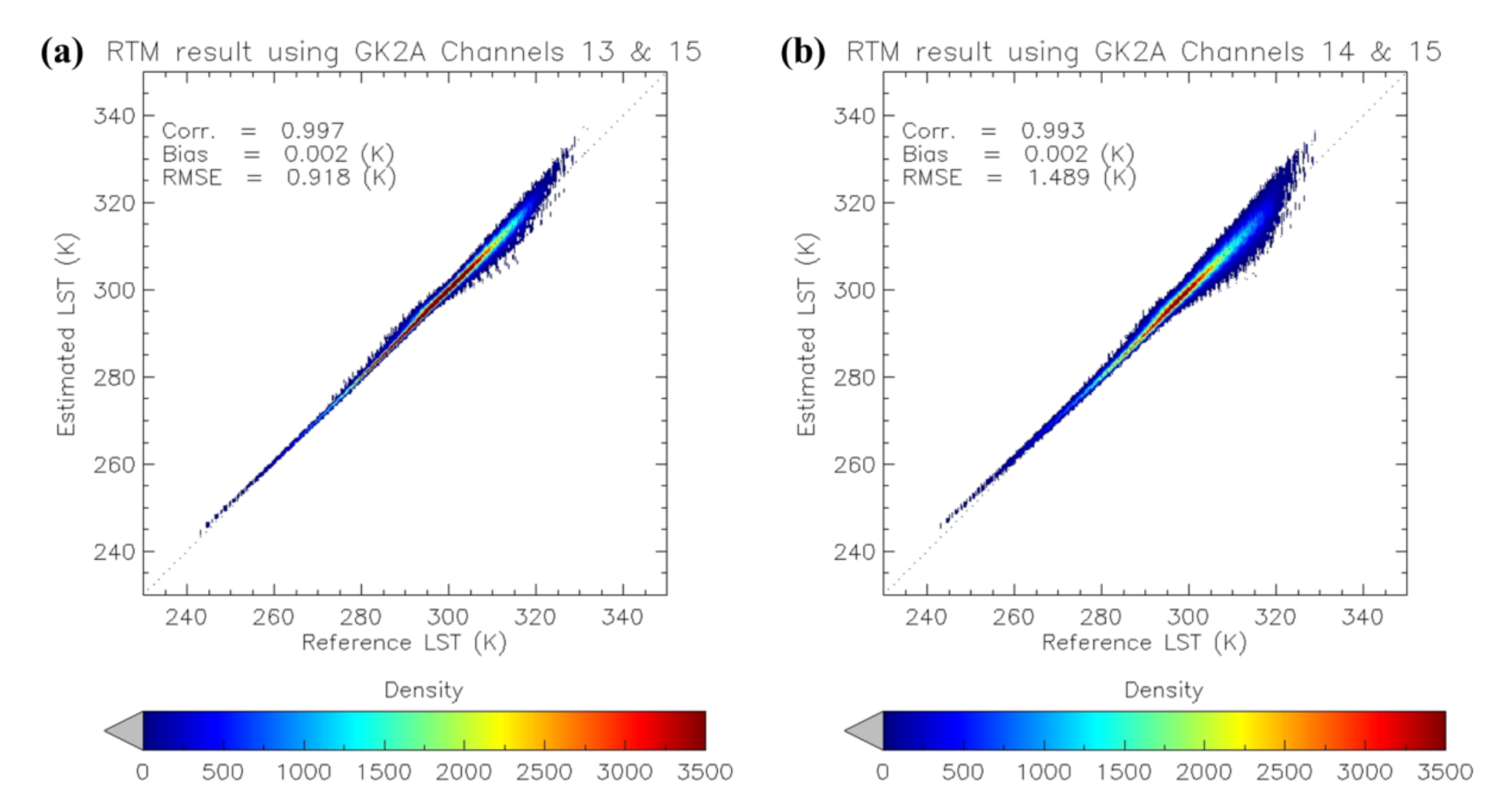
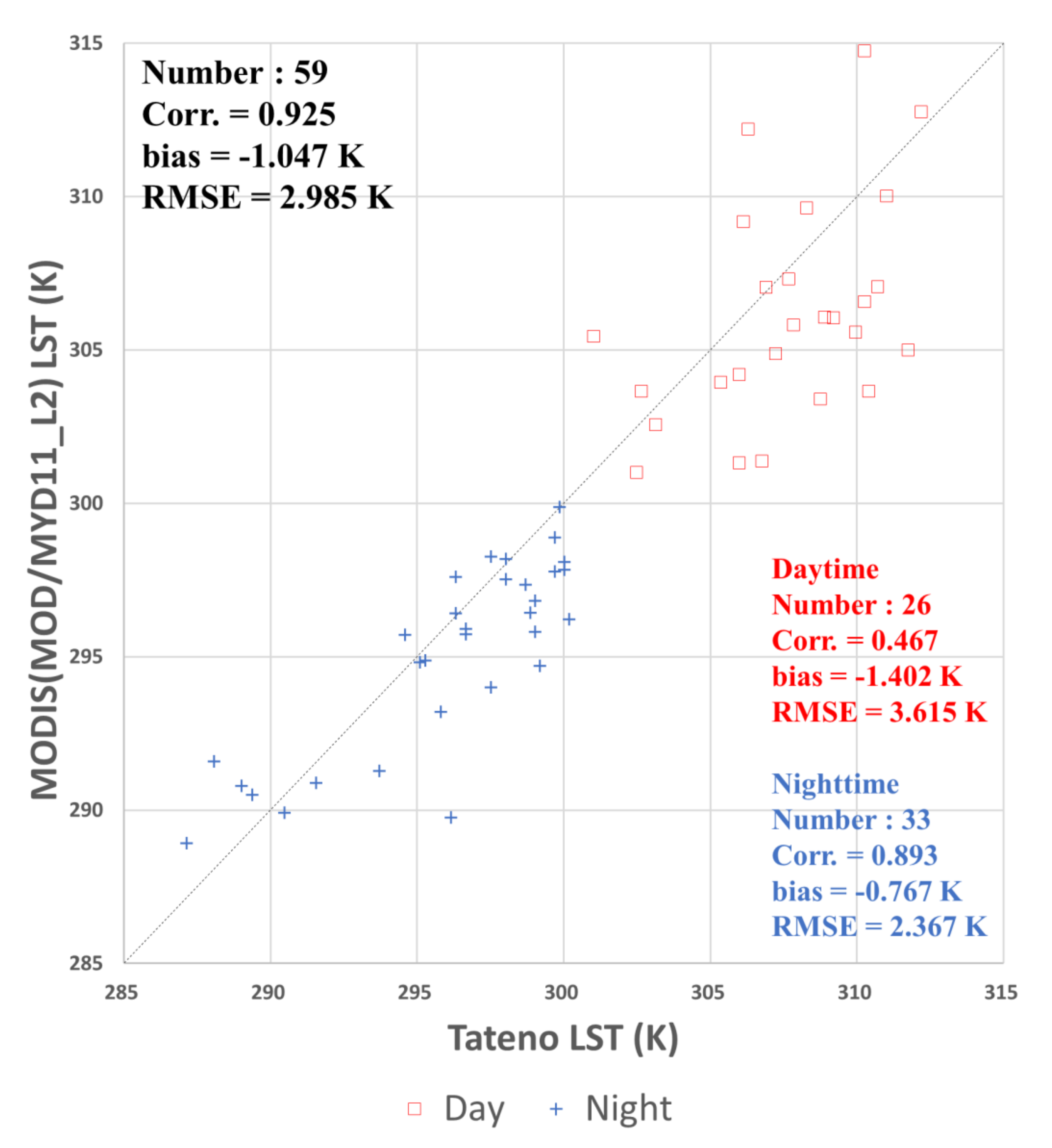
| Name | Spatial Resolution (km) | Temporal Resolution | Description |
|---|---|---|---|
| Channel 13 | 2 | 10 min | Center wavelength: 10.3539 μm |
| Channel 15 | 2 | 10 min | Center wavelength: 12.3651 μm |
| GK2A Cloud mask data | 2 | 10 min | Distinguish clear and cloud pixel |
| GK2A Land surface emissivity of Ch. 13 | 2 | 1 day | Input data of GK2A LST |
| GK2A Land surface emissivity of Ch. 15 | 2 | 1 day | Input data of GK2A LST |
| Impacting Factors | Detailed Conditions | |
|---|---|---|
| Atmospheric profiles | 2694 SeeBor version 5 database (Viewing zenith angle is lesser than 50°) | |
| Land surface temperature | Day: Ta − 2 K~Ta + 18 K (a step of 2 K) | |
| Night: Ta − 6 K~Ta + 2 K (a step of 2 K) | ||
| Diurnal variation of air temperature | 1013 hPa (= Ta) 986 hPa 958 hPa 931 hPa 904 hPa | ΔT = LST – Ta T(1013)’ = T(1013) + 1/2 ΔT T(986)’ = T(986) + 1/3 ΔT T(958)’ = T(958) + 1/6 ΔT T(931)’ = T(931) + 1/12 ΔT T(904)’ = T(904) + 1/24 ΔT |
| Land surface emissivity | : 0.9400~0.9900 (a step of 0.005, 11 steps) | |
| −0.02 0.01 (a step of 0.003, 11 steps) | ||
| if () > 1, = 0.9999 | ||
| Conditions | ||||||||
|---|---|---|---|---|---|---|---|---|
| Day | Dry | −3.7535 | 1.0146 | 0.4355 | −0.7514 | 0.5270 | 46.4021 | −76.7542 |
| Normal | −2.5794 | 1.0094 | 0.5482 | 0.1148 | 1.0890 | 57.0411 | −71.3507 | |
| Wet | 44.8058 | 0.8136 | 3.3273 | −0.0664 | 2.7271 | 62.8262 | −74.7224 | |
| Night | Dry | 2.4418 | 0.9920 | 0.7575 | −0.3311 | 0.0106 | 45.8389 | −75.3720 |
| Normal | −4.8096 | 1.0181 | 0.2986 | 0.1573 | 1.0668 | 50.1998 | −49.2833 | |
| Wet | 21.1556 | 0.8973 | 3.5049 | −0.1219 | 1.7965 | 51.9677 | −52.6384 | |
| Month | MOD11_L2 | MYD11_L2 | ||||||
|---|---|---|---|---|---|---|---|---|
| # of Pixel | Corr. | Bias (K) | RMSE (K) | # of Pixel | Corr. | Bias (K) | RMSE (K) | |
| 2019.07 | 22,412 | 0.961 | 1.051 | 2.139 | 20,485 | 0.965 | 1.182 | 2.236 |
| 2019.08 | 7022 | 0.960 | 1.049 | 2.045 | 7279 | 0.974 | 1.117 | 2.129 |
| 2019.09 | 21,262 | 0.958 | 1.406 | 2.484 | 18,120 | 0.977 | 1.163 | 2.257 |
| 2019.10 | 10,577 | 0.980 | 1.598 | 2.601 | 9397 | 0.988 | 1.260 | 2.237 |
| Total and Ave. | 61,275 | 0.963 | 1.269 | 2.328 | 55,282 | 0.974 | 1.180 | 2.229 |
| Month | Daytime | Nighttime | ||||||
|---|---|---|---|---|---|---|---|---|
| # of Pixel | Corr. | Bias (K) | RMSE (K) | # of Pixel | Corr. | Bias (K) | RMSE (K) | |
| 2019.07 | 18,905 | 0.948 | 1.890 | 2.981 | 23,992 | 0.976 | 0.502 | 1.559 |
| 2019.08 | 6,969 | 0.953 | 1.889 | 2.839 | 7,332 | 0.981 | 0.318 | 1.375 |
| 2019.09 | 18,076 | 0.946 | 2.340 | 3.486 | 21,306 | 0.985 | 0.407 | 1.441 |
| 2019.10 | 9,595 | 0.978 | 2.269 | 3.419 | 10,378 | 0.990 | 0.671 | 1.515 |
| Total and Ave. | 53,547 | 0.953 | 2.110 | 3.211 | 63,010 | 0.982 | 0.476 | 1.490 |
| Algorithm | Daytime | Nighttime | ||||||
|---|---|---|---|---|---|---|---|---|
| # of Pixel | Corr. | bias (K) | RMSE (K) | # of Pixel | Corr. | bias (K) | RMSE (K) | |
| Linear | 18,076 | 0.944 | 2.504 | 3.691 | 21,306 | 0.985 | 0.413 | 1.670 |
| Non-linear | 18,076 | 0.946 | 2.340 | 3.486 | 21,306 | 0.985 | 0.407 | 1.441 |
© 2020 by the authors. Licensee MDPI, Basel, Switzerland. This article is an open access article distributed under the terms and conditions of the Creative Commons Attribution (CC BY) license (http://creativecommons.org/licenses/by/4.0/).
Share and Cite
Choi, Y.-Y.; Suh, M.-S. Development of a Land Surface Temperature Retrieval Algorithm from GK2A/AMI. Remote Sens. 2020, 12, 3050. https://doi.org/10.3390/rs12183050
Choi Y-Y, Suh M-S. Development of a Land Surface Temperature Retrieval Algorithm from GK2A/AMI. Remote Sensing. 2020; 12(18):3050. https://doi.org/10.3390/rs12183050
Chicago/Turabian StyleChoi, Youn-Young, and Myoung-Seok Suh. 2020. "Development of a Land Surface Temperature Retrieval Algorithm from GK2A/AMI" Remote Sensing 12, no. 18: 3050. https://doi.org/10.3390/rs12183050
APA StyleChoi, Y.-Y., & Suh, M.-S. (2020). Development of a Land Surface Temperature Retrieval Algorithm from GK2A/AMI. Remote Sensing, 12(18), 3050. https://doi.org/10.3390/rs12183050





